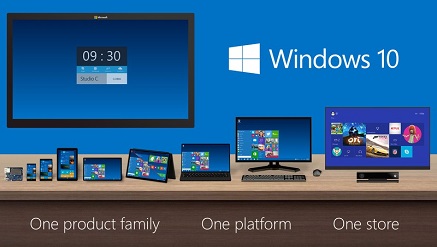E-Business
Windows 10 to get Updates from Multiple Sources

Windows 10 will apparently let user download updates from computers other than Microsoft’s own servers. The latest build of the upcoming OS, leaked online over the weekend, reveals a new option for getting updates from more than one place, The Verge reported.
Specifically, you can choose to download updates for the operating system from other PCs on your own internal network or from PCs either on your network or over the Internet, giving the update process a peer-to-peer capability.
Windows 10, Microsoft’s first big chance to move beyond the missteps of Windows 8, is expected to get its official release to the public later this year.
Currently, updates for Windows, Office and other Microsoft products are downloaded directly from Microsoft servers.
But if Microsoft’s site is too slow or inaccessible for some reason, you’ll now have an alternative avenue for making sure your PC can get the latest security patches, bug fixes and other updates.
As an example, let’s say you own three different Windows 10 PCs or tablets. You can download the latest updates onto one from Microsoft or from PCs over the Internet and then download them onto your other two devices from your first PC.
The option seen in the leaked screenshot posted by The Verge gives you the ability to “download apps and OS updates from multiple sources to get them more quickly.”
So that means you’ll also be able to grab updates to Windows 10 apps as well as those for the operating system itself. You can then choose whether to download updates from Microsoft and PCs on your local network or from Microsoft, PCs on your network and other PCs over the Internet.
Downloading updates from other PCs in a peer-to-peer fashion does open up issues of security and reliability. But Microsoft would certainly be aware of the potential pitfalls and is likely taking steps to ensure that any updates received from other PCs over the Internet would be safe and secure.
Unofficially shared on various torrent sites Saturday, the latest Windows 10 build also displays a transparent Start menu, a new interface for Wi-Fi connections and enhancements to the virtual desktop that lets you jump from desktop to another, The Verge said.
Though the latest leaked build is unofficial, Microsoft has been rolling out new builds to the Windows 10 Technical Preview on a semi-regular basis.
The company aims the builds at people who sign up for the Windows Insider Program with the hope of getting them to provide feedback on the OS as it’s being crafted.
Microsoft offers preview builds on both a “fast” and “slow” basis. Fast means you’ll see more previews released but they may contain more bugs.
Slow means the previews will be doled out to you at a more leisurely rate but they may be a bit more stable.
Earlier this month, Microsoft general manager admitted that the company has “probably been too conservative about pushing builds to the Fast ring for Windows Insiders.” As a result, the fast builds should now start to come out faster.
E-Business
Cyberattacks: ‘56 Percent of Cases Stem from Existing Logins

A new report by Sophos, ybersecurity firm, has said that attackers primarily gained initial network access—56 per cent of all MDR and IR cases—by exploiting external remote services like firewalls and VPNs using valid credentials.

The 2025 Sophos Active Adversary Report details attacker behavior and techniques from over 400 Managed Detection and Response [MDR] and Incident Response [IR] cases in 2024.
According to the report, the combination of external remote services and valid accounts align with the top root causes of attacks.
For the second year in row, compromised credentials were the number one root cause of attacks [41% of cases]. This was followed by exploited vulnerabilities [21.79%] and brute force attacks [21.07%].
When analysing MDR and IR investigations, the Sophos X-Ops team looked specifically at ransomware, data exfiltration, and data extortion cases to identify how fast attackers progressed through the stages of an attack within an organisation.
In those three types of cases, the median time between the start of an attack and exfiltration was only 72.98 hours [3.04 days]. Furthermore, there was only a median of 2.7 hours from exfiltration to attack detection.
“Passive security is no longer enough. While prevention is essential, rapid response is critical. Organisations must actively monitor networks and act swiftly against observed telemetry.
Coordinated attacks by motivated adversaries require a coordinated defense. “For many organisations, that means combining business-specific knowledge with expert-led detection and response.
Our report confirms that organizations with proactive monitoring detect attacks faster and experience better outcomes,” said John Shier, field CISO.
The 2025 Sophos Active Adversary Report further reveals that attackers can move quickly, with a median of just 11 hours between initial access and a breach attempt on Active Directory, a critical asset in Windows environments.
Akira emerged as the most prevalent ransomware group in 2024, followed by Fog and LockBit, the latter still active despite a major takedown.
Attack detection has improved overall, with dwell time—the time attackers remain undetected—dropping from four days to just two, thanks largely to the inclusion of MDR (Managed Detection and Response) cases.
Dwell time varied depending on the type of case: it held steady at 4 days for ransomware and 11.5 days for non-ransomware cases in incident response (IR) investigations.
In contrast, MDR cases showed much faster response times—3 days for ransomware and just 1 day for non-ransom – ware attacks.
The report also highlights that 83% of ransomware deployments occurred outside local business hours, showing attackers favor overnight activity.
Additionally, Remote Desktop Protocol (RDP) was exploited in 84% of cases, making it the most commonly abused Microsoft tool.
To strengthen their cybersecurity posture, Sophos advises organizations to take several key steps.
First, they should close any exposed Remote Desktop Protocol (RDP) ports and implement phishing-resistant multifactor authentication (MFA) wherever feasible to reduce unauthorized access risks.
Additionally, companies should prioritize timely patching of vulnerable systems, especially those exposed to the internet. Deploying Endpoint Detection and Response (EDR) or Managed Detection and Response (MDR) solutions with 24/7 monitoring is crucial.
Finally, having a well-defined incident response plan—and regularly testing it through simulations or tabletop exercises—can greatly improve preparedness for potential attacks.
E-Business
Kaspersky Presents Insight on 14% Increase in Spyware Attacks on Businesses in Africa @ GITEX Africa

As part of the company’s participation at the GITEX Africa conference, taking place in Morocco on 14-16 April 2025, Kaspersky will address the dynamics for cyberthreats in the African region as per the latest anonymised data from the Kaspersky Security Network (KSN)¹.

From 2023 to 2024 businesses in Africa were targeted by web threats, on-device threats, and attacks aiming to steal data, including spyware and password stealers.
Phishing and ransomware continue to be significant threats in the region, with 66 million phishing link clicks seen by Kaspersky in the African region in 2024, including over 14.8 million phishing link clicks by corporate users.
Web-based threats, or online threats, are a category of cybersecurity risks that may cause an undesirable event or action affecting users browsing the Internet.
According to Kaspersky data, there were 131 580 587 web threats detected in 2024 in the African region, including almost 20 million attack attempts in Kenya, almost 17 million in South Africa, and 12.6 million in Morocco. Businesses were targeted by web threats more often in 2024 than in 2023, with threat detections increasing by 1.2%.
Local (on device) threats include malware that is spread via removable USB drives, CDs and DVDs, or that initially makes way onto the computer in non-open form (for example, programs in complex installers, encrypted files, etc.).
According to Kaspersky telemetry, local (on device) threat detections in organisations in the African region in 2024 increased by 4% compared to 2023. Among the countries that saw growth in local threats detected in organisations were Nigeria (169% increase), Ethiopia (86%), South Africa (32%), Senegal (11%), and Morocco (9%).
There has been a spike of threats related to data theft. According to Kaspersky data, there was a 14% growth in spyware attack detections on businesses in the African region from 2023 to 2024.
Spyware is secretly installed on a user’s computer to monitor their actions and collect their data. Apart from that, there has been a 26% increase in password stealer detections. Password stealers are a type of malware designed to harvest login credentials and other sensitive data.
“Our statistics show an increase in attack detections for several types of cyberthreats, and the factors driving these increases are multifaceted. In the B2B sector, the continuing shift toward hybrid work models and the rush to digitise operations — often outpacing cybersecurity investments — may leave businesses in Africa exposed to advanced persistent threats.
In the B2C space, the explosion of digital financial services, coupled with low digital literacy rates, makes individuals prime targets for opportunistic attacks,” comments Maher Yamout, Lead Cybersecurity Researcher with Kaspersky Global Research and Analysis Team.
“Organisations in Africa should prioritise a unified approach by enhancing collaboration, investing in specialised cybersecurity training, and promoting digital literacy to effectively combat the rising tide of cybercrime. Initiatives like the African Cyber Surge operation and targeted educational programs can serve as blueprints for building a resilient digital ecosystem across the continent.”
E-Business
Africa Plans to Establish a $60Bn AI Fund

A $60 billion Africa AI Fund is set to be established, leveraging public, private, and philanthropic capital. The goal is to build a secure, inclusive, and competitive African AI economy through foundational and catalytic investment, according to a declaration made at the recent Global AI Summit on Africa in Kigali, Rwanda.

The declaration seeks to leverage the potential of AI to drive innovation and competitiveness to advance Africa’s economies, industries, and societies. Second, to position Africa as a global leader in ethical, trustworthy, and inclusive AI adoption.
The declaration also seeks to foster the sustainable and responsible design, development, deployment, use, and governance of AI technologies in Africa.
The memorandum was facilitated by Qhala, Smart Africa, Rwanda’s Centre for the Fourth Industrial Revolution, and supported by the Gates Foundation.
Qhala is an AI enabler dedicated to driving innovation and digital transformation across Africa.
In a statement, Qhala said the declaration outlines shared commitment among African nations to align national strategies with continental goals, safeguard data sovereignty, build digital infrastructure, and foster a sustainable AI innovation ecosystem.
The organisation went on to say Africa’s AI landscape is changing at a fast pace and it is projected to contribute $2.9 trillion to the African economy by 2030.
Shikoh Gitau, CEO of Qhala, said: “This declaration is timely, as Africa’s AI ecosystem is rapidly evolving but remains fragmented and underfunded. This will ensure that Africa takes its place in a leadership role in global AI development.”
Lacina Koné, CEO of Smart Africa, added: “AI is not just technology to us, it’s an African arrow that, when thrown with the right ethical frameworks and inclusive policies, can pierce the way to African digital prosperity and resilience for the benefit of every citizen.”

 E-Business1 day ago
E-Business1 day agoCyberattacks: ‘56 Percent of Cases Stem from Existing Logins

 General News3 days ago
General News3 days agoAFD Commits €3m to Africa’s Financial Inclusion

 E-Financial3 days ago
E-Financial3 days agoVerve Expands Payment Frontiers with Global Partnerships, Contactless Innovation

 News2 days ago
News2 days agoSenate Committee Partners with Kuda Bank to Tackle Compliance Crisis as Nigeria Loses ₦3.4 Trillion

 Broadcasting1 day ago
Broadcasting1 day agoSubscriber Withdraws Suit against MultiChoice, FCCPC over Price Hike

 E-Business2 days ago
E-Business2 days agoKaspersky Presents Insight on 14% Increase in Spyware Attacks on Businesses in Africa @ GITEX Africa

 General News3 days ago
General News3 days agoEU Aims to Remove Barriers to AI Development

 News3 days ago
News3 days agoFG Inaugurates Board of Galaxy Backbone


























